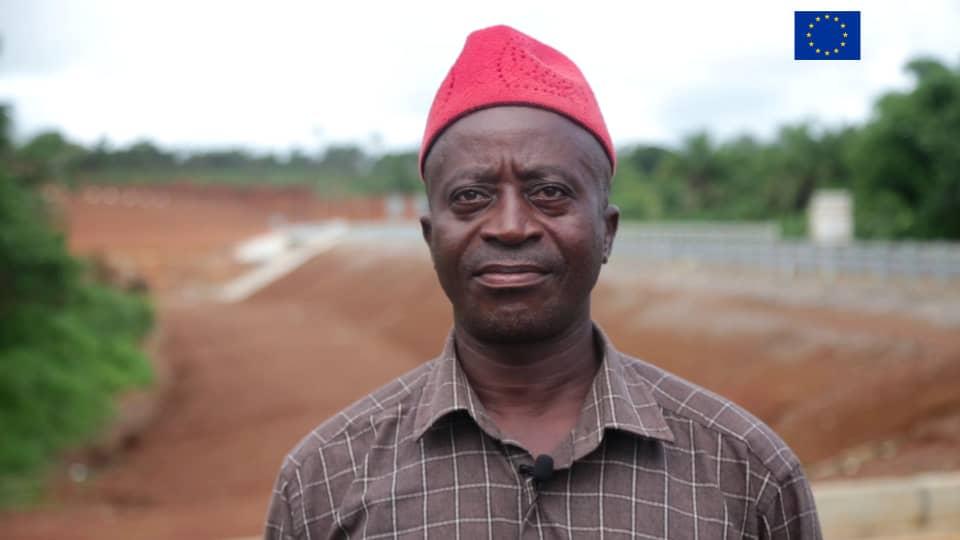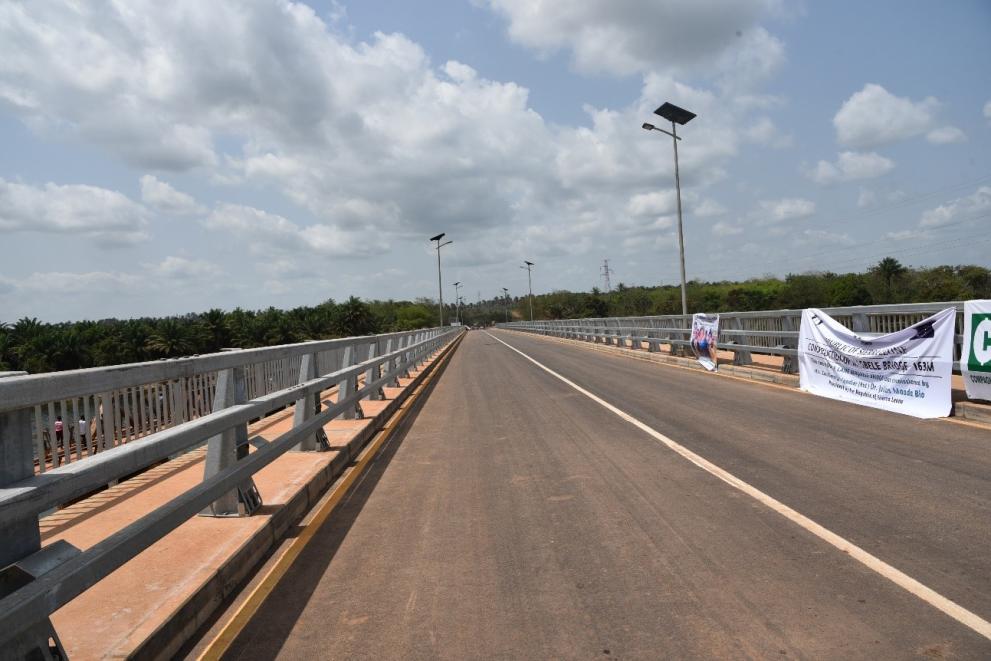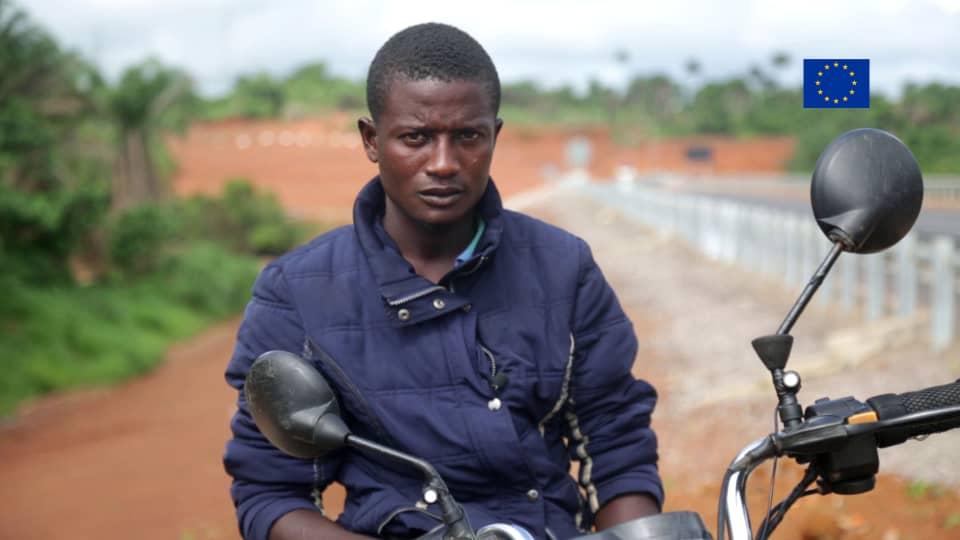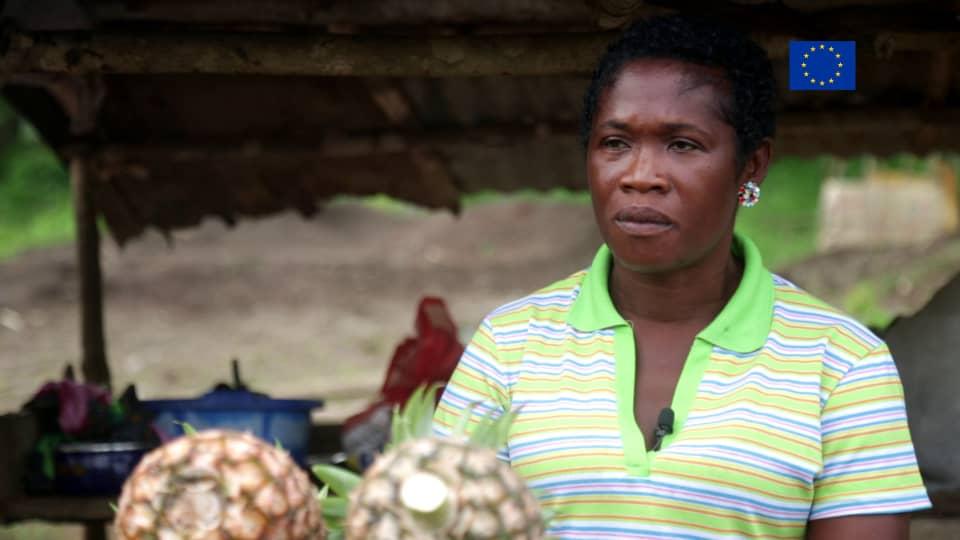The EU has been engaged in supporting major road infrastructure investments in Sierra Leone since many years. Improving connectivy means reducing travel time and costs, and enhancing economic inegration and trade.
The recent inauguration of the Magbele and Mabang bridges has shown the EU’s commitment to continue strengthening connectivity and socio-economic development in Sierra Leone and in the West African region. These bridges, along with other EU-funded infrastructure projects in Sierra Leone, are key to buidling the West African strategic corridors and the Africa-Europe Global Gateway.
The Magbele bridge was inaugurated on 14 May 2022 after 10 years of planning and construction work. The bridge crosses the Rokel river along the highway that connects Freetown to Conakry and the Northern regions of Sierra Leone. It replaces the old single lane bridge which only allowed traffic in one direction at a time.
Pa Kapri Kanu is a community leader of the Robonka community in Port Loko district. He lives with his family 50 meters away from the Magbele bridge and is thankful to the EU for financing the construction of the new bridge and the road extension.
“The Magbele bridgeis contributing to the development of not only my community but also the country as a whole. The new double-lane bridge has shortened traveling time to and from Freetown, Guinea and other parts of the country. In the past, there used to be long traffic, because the old bridge was built to accommodate vehicular traffic in only one direction at a time.” Pa Kapri explains

Since the new bridge was opened, things have changed a lot for the people in my community. The road and bridge have a safe and secured footpath with guarded rails for pedestrians to walk from one end to other without any fear of being knocked-down by vehicles.
But, with the new road and bridge, life is getting better reports Pa Kapri: "We have no fear of sending our children to school anymore, since they use the footpath to walk across the bridge to school without putting their lives in danger. Women, the youth and the men too can now go to the market to buy and sell their products to travellers along the road. They even return at night with no fear, because there are solar-powered lights deployed across the entire length of the bridge in the community. This has helped to improve their businesses and has guaranteed the safety of road users and vehicles plying this very busy road.”
Rebecca Marrah is a roadside trader who lives at Masiaka and comes to Robonka to sell fruit. She has been selling fruit to people who mostly travel to Freetown and other parts of the country. Rebecca is a single parent with two children and depends solely on her business for her livelihood, enabling her to cater for the needs of her children and pay their school charges. She is thankful for this construction which changed her life for the better:
“I want to thank the European Union for building this new Magbele Bridge. We sell more fruits now and make more money. We do not have to chase cars and put our lives at risk anymore. The old bridge and the approach road was very narrow with no space for vehicles. I can recall one evening while I was running to sell fruits a car knocked me down and broke my leg.” Rebecca recalls.
“This new bridge is bigger which allows two cars to run at the same time without any obstruction to traffic flow. I now spend longer hours at the market to do business before going home, because I know I can travel back home safely with my children. In fact, this has made things very easy for us, we just display our products and travellers buy from us. I now do more trips with my motorbike compared to the past. I can even ride my bike across the bridge at night because there are solar lights; it is safe. This is a very important development for the people and it is contributing a lot to improve our lives.”

Gbassay Kabia is a commercial motorcyclist who lives in Rogebre town making a lining from transporting people on his motorcycle. Gbassay explains how things used to be: “I have been engaged in this ‘okada rider’ commercial motorcycle riding business for two years now. However, things were very difficult for us in the past, especially when we had to wait for long hours in traffic to go across the bridge. We were even afraid to use the old bridge at night, because it was very dangerous. I lost my best friend on that old bridge when he was involved in an accident last year.
“There were many other challenges we encountered as okada riders. We were not able to make enough money at all… For now, I have seen a lot of changes when this new bridge was opened. We now have a car park by the new bridge where we pick up and drop passengers who hire us to travel to other locations off the highway. I now do more trips with my motorbike compared to the past. I can even ride my bike across the bridge at night because there are solar lights which makes it very safe for us. It is a very important development for the people and it is contributing a lot to improve our lives.”

The Mabang bridge connects Sierra Leone’s Northwestern and Southern regions. It is Sierra Leone’s longest bridge of this kind of structure built in recent times, and also the country’s second longest bridge after Aberdeen bridge in Freetown. The new bridge replaced an old railway steel bridge converted for vehicular traffic that collapsed in 2013. Since then, and until the opening of the new bridge, crossing the Ribbi river had only been possible with a hand-pulled ferry and other small boats.
Sallay Kanu is a petty trader who lives at Kagboro and buys agricultural products which he then sells in Freetown. He used to spend 3 nights just waiting for the ferry to take passengers across the river. He explains: “Using this road is the shortest means to travel and transport goods from Moyamba and Bonthe districts to Freetown. Since the old railway Mabang Bridge collapsed over the Ribbi river more than 9 years ago, we faced a lot of difficulties to travel and transport goods to Freetown. When the bridge collapsed at Mabang, the hand-pulled ferry, which was used to transport vehicles carrying our goods across the river, was faulty and broke down frequently.”

The bridge has opened up economic activity in our region. We are seeing big trucks from Guinea and Freetown now bring goods to sell here. They also buy our products in the community.
Before the bridge was built, perishable goods were spoiled, creating glosses for businesses and for those travelling to Freetown and the northern region. The small canoes that were used as an alternative to the ferry couldn't carry heavy goods. There were countless accidents in the river, particularly during the rainy season and when the tides were high. Many lives and properties worth millions of Leones were lost.
“This new Mabang Bridge is the game changer: different kinds of trucks and cars are now plying the route, carrying people and goods to Freetown at a cheaper rate. Before the bridge was built, it would cost one person up to SLL 90,000 the transport fare from Moyamba to the Ribbi river. Now, due to the increasing number of public transports, there has been a reduction of transport fare to SLL 60,000 per person. I have been saving money and time to travel and do business.
"The bridge has opened up economic activity in our region. We are seeing big trucks from Guinea and Freetown now bring goods to sell here. They also buy our products in the community. I do not have to travel to Freetown all the time to sell, because I can still make profit from customers who come here to buy from me. I am also seeing so many other facilities like medical facilities, and big shops selling a variety of goods at almost the same price like in Freetown. This is an improvement for the community and the region and I know we will continue to see more development.”
About the project and EU contribution
Since 2004, the EU has financed the reconstruction and rehabilitation of 355 km of road in Sierra Leone along the Praia-Dakar-Abidjan corridor. EU-funded constructions in this area amount to €157 million and include:
- Several new bridges, three of which are longer than 150 m
- 85 km of road and the Magbele bridge along the Freetown-Conakry highway
- Widening and improvement of 7 bridges along the highway connecting Freetown with Bo and the Liberian border, including a 162 m long bridge over the Moa river which replaces a ferry.
- Essential road links to the corridor
Finalisation of ongoing works is expected by the second half of 2023.
